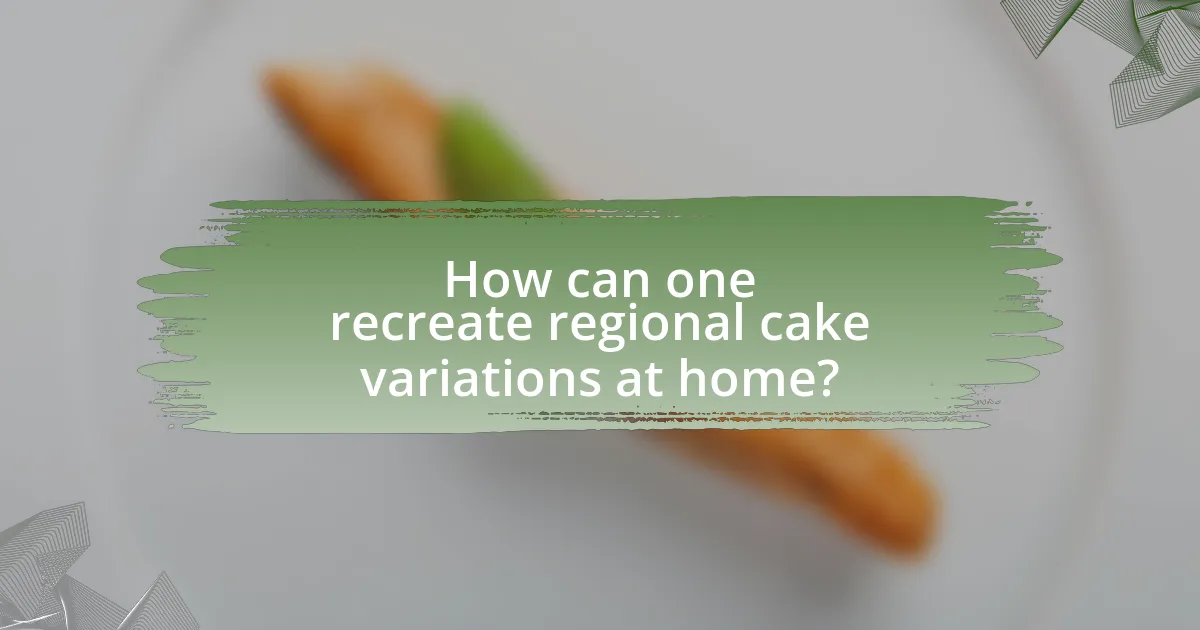The article explores regional cake variations from around the world, highlighting iconic desserts such as Italian Tiramisu, French Galette des Rois, and German Black Forest Cake. It examines how cultural influences shape cake recipes through local ingredients and traditions, as well as the significance of cakes in celebrations and festivals. The article also discusses common ingredients, baking techniques, and the historical context that informs regional cakes, emphasizing the importance of understanding these variations for culinary appreciation and cultural connection. Additionally, it provides practical tips for recreating these cakes at home, including sourcing authentic ingredients and mastering specific baking techniques.

What are the different regional cake variations around the world?
Different regional cake variations around the world include the Italian Tiramisu, a coffee-flavored dessert made with layers of mascarpone cheese and ladyfingers; the French Galette des Rois, a puff pastry cake filled with almond cream, traditionally served during Epiphany; and the German Black Forest Cake, which features layers of chocolate sponge, cherries, and whipped cream. Each of these cakes reflects local ingredients and cultural traditions, showcasing the diversity of cake-making practices globally. For instance, Tiramisu originated in the Veneto region of Italy in the 1960s, while the Black Forest Cake is rooted in the Black Forest region of Germany, known for its rich chocolate and cherry production.
How do cultural influences shape cake recipes in various regions?
Cultural influences shape cake recipes in various regions by integrating local ingredients, traditions, and customs into the baking process. For instance, in Italy, the use of ricotta cheese in traditional cakes like Cassata reflects the country’s dairy farming practices and regional flavors, while in Japan, the incorporation of matcha in cakes showcases the significance of green tea in Japanese culture. Additionally, festivals and celebrations often dictate cake styles; for example, in Mexico, Tres Leches cake is popular during birthdays and special occasions, highlighting the cultural importance of communal gatherings. These regional variations demonstrate how cultural heritage directly impacts the ingredients and methods used in cake recipes, resulting in unique culinary expressions across the globe.
What ingredients are commonly used in regional cakes?
Common ingredients in regional cakes include flour, sugar, eggs, and butter, which serve as the foundational components in many recipes. Additionally, regional variations often incorporate local flavors and ingredients such as fruits, nuts, spices, and dairy products. For instance, Italian panettone features candied fruits, while German Black Forest cake includes cherries and whipped cream. These specific ingredients reflect cultural preferences and local agricultural products, demonstrating the diversity of cake recipes worldwide.
How do baking techniques differ across cultures?
Baking techniques differ across cultures primarily due to variations in ingredients, methods, and traditions. For instance, in France, techniques such as folding and layering are essential for creating pastries like croissants, which rely on precise temperature control and butter lamination. In contrast, traditional Japanese baking often incorporates rice flour and utilizes steaming methods, as seen in mochi, which results in a chewy texture distinct from Western baked goods. Additionally, Middle Eastern baking frequently employs spices and nuts, with techniques like layering dough in baklava, highlighting regional flavor profiles. These cultural distinctions in baking are shaped by local resources, historical influences, and culinary practices, demonstrating the diversity of baking techniques worldwide.
What are some iconic cakes from specific regions?
Some iconic cakes from specific regions include the Black Forest Cake from Germany, which features layers of chocolate sponge, cherries, and whipped cream, and is named after the Black Forest region. Another example is the Tiramisu from Italy, a coffee-flavored dessert made with layers of mascarpone cheese and ladyfingers soaked in coffee. In the United States, the Red Velvet Cake is notable for its vibrant red color and cream cheese frosting, originating from the Southern states. Each of these cakes reflects the culinary traditions and ingredients of their respective regions, showcasing unique flavors and preparation methods.
What makes the Black Forest Cake unique to Germany?
Black Forest Cake is unique to Germany primarily due to its specific ingredients and traditional preparation methods that reflect the region’s culture. This cake features layers of chocolate sponge cake, whipped cream, and cherries, particularly the use of sour Morello cherries, which are native to the Black Forest region. Additionally, the cake is often flavored with Kirsch, a cherry schnapps that enhances its distinct taste. The combination of these elements, along with its historical roots dating back to the early 20th century, solidifies its status as a quintessential German dessert.
How does the Tres Leches Cake represent Latin American culture?
Tres Leches Cake represents Latin American culture through its rich history and unique ingredients that reflect the region’s culinary traditions. Originating in Latin America, particularly in countries like Mexico, Nicaragua, and Venezuela, this cake is made with three types of milk: evaporated milk, condensed milk, and heavy cream, symbolizing the blending of indigenous and colonial influences in Latin American cuisine. The cake’s moist texture and sweet flavor highlight the region’s preference for indulgent desserts, while its popularity at celebrations and gatherings underscores the importance of community and family in Latin American culture.

Why is it important to explore regional cake variations?
Exploring regional cake variations is important because it enhances cultural appreciation and culinary diversity. Each region’s cakes reflect local ingredients, traditions, and historical influences, showcasing unique flavors and techniques. For instance, the use of specific spices in Indian cakes or the incorporation of local fruits in Caribbean desserts illustrates how geography and culture shape culinary practices. Understanding these variations fosters a deeper connection to global cultures and promotes the preservation of culinary heritage.
How do regional cakes reflect local traditions and celebrations?
Regional cakes embody local traditions and celebrations by incorporating specific ingredients, flavors, and preparation methods that are unique to a culture or region. For instance, the use of local fruits, nuts, and spices in cakes often reflects the agricultural practices and seasonal availability of those items, such as the use of citrus in Mediterranean cakes during harvest festivals. Additionally, cakes are often central to cultural rituals, such as wedding cakes in Western cultures symbolizing unity or mooncakes during the Mid-Autumn Festival in China, which represent reunion and harmony. These cakes not only serve as culinary expressions but also as markers of identity, history, and community values, reinforcing the significance of local customs and celebrations.
What role do cakes play in cultural festivals and holidays?
Cakes serve as significant symbols of celebration during cultural festivals and holidays. They often represent communal joy, marking important life events such as birthdays, weddings, and religious observances. For instance, in many cultures, cakes are integral to festivities like Christmas, where fruitcake is traditionally served, symbolizing abundance and celebration. Similarly, during Diwali, the Indian festival of lights, sweets and cakes are shared among families and friends, reinforcing social bonds and cultural heritage. The preparation and sharing of cakes during these occasions also reflect regional variations, showcasing local ingredients and baking traditions, which further enrich the cultural tapestry.
How can understanding regional cakes enhance culinary appreciation?
Understanding regional cakes enhances culinary appreciation by providing insight into cultural traditions and local ingredients. Each regional cake reflects the history, climate, and agricultural practices of its area, showcasing unique flavors and techniques. For example, the use of local fruits in a cake from a specific region can highlight the agricultural bounty of that area, while traditional baking methods can reveal historical influences. This knowledge fosters a deeper connection to the food, allowing individuals to appreciate not just the taste but also the stories and heritage behind each cake.
What can we learn from the history of regional cakes?
The history of regional cakes reveals cultural diversity and local ingredients that shape culinary traditions. Each regional cake reflects the history, geography, and agricultural practices of its area, showcasing how communities adapt recipes based on available resources. For example, the use of cornmeal in Southern U.S. cakes highlights the agricultural significance of corn in that region, while the incorporation of spices in Indian cakes illustrates the influence of trade routes and cultural exchanges. This historical context provides insight into how food evolves and connects people to their heritage and environment.
How have historical events influenced cake recipes?
Historical events have significantly influenced cake recipes by introducing new ingredients, techniques, and cultural practices. For instance, the introduction of sugar from the Caribbean during the colonial period transformed cake-making, allowing for sweeter and more elaborate desserts. Additionally, the Industrial Revolution led to the mass production of baking powder and other leavening agents, which simplified cake preparation and made it accessible to a broader audience. Furthermore, events such as the World Wars prompted rationing, resulting in the creation of recipes that utilized limited resources, like the famous “war cake,” which often omitted eggs and milk. These historical contexts illustrate how societal changes and resource availability have shaped the evolution of cake recipes globally.
What stories do regional cakes tell about their origins?
Regional cakes often reflect the cultural, historical, and geographical influences of their origins. For example, the Italian Panettone, traditionally enjoyed during Christmas, tells the story of Milan’s rich baking heritage and the influence of the Renaissance, showcasing ingredients like candied fruits and rich dough that symbolize abundance and celebration. Similarly, the French Galette des Rois, associated with Epiphany, highlights the tradition of the Three Kings and incorporates local customs, emphasizing the importance of community and festivity. These cakes serve as culinary narratives, preserving local traditions and historical events, while also adapting to regional tastes and available ingredients, thus embodying the essence of their cultural backgrounds.

How can one recreate regional cake variations at home?
To recreate regional cake variations at home, one should start by researching specific recipes that represent the desired region’s traditional cakes, such as Italian Tiramisu or German Black Forest Cake. Following authentic recipes ensures the use of traditional ingredients and techniques, which are crucial for achieving the original flavor and texture. For instance, Tiramisu requires mascarpone cheese and espresso, while Black Forest Cake features layers of chocolate sponge, cherries, and whipped cream. Utilizing local or specialty ingredients can enhance authenticity, as many regional cakes rely on specific flavors unique to their area. Additionally, watching tutorial videos or reading blogs from native bakers can provide insights into techniques and tips that are not always included in written recipes. This approach not only helps in accurately recreating the cakes but also enriches the baking experience by connecting with the cultural significance of each cake.
What are some essential tips for baking regional cakes?
To successfully bake regional cakes, it is essential to understand the specific ingredients and techniques that define each cake’s unique characteristics. For instance, using local ingredients such as specific flours, fruits, or spices enhances authenticity and flavor, as seen in Italian Panettone which relies on high-quality flour and candied fruits. Additionally, mastering regional baking methods, like the creaming technique for British cakes or the use of steam in German cakes, is crucial for achieving the desired texture and rise. Understanding the cultural significance of each cake can also guide the baking process, ensuring that traditional practices are honored, such as the use of specific molds or decoration styles that reflect the cake’s heritage.
How can one source authentic ingredients for regional cakes?
To source authentic ingredients for regional cakes, one should establish connections with local farmers, specialty markets, and regional suppliers. Local farmers often provide fresh, traditional ingredients that are integral to the authenticity of regional cakes, such as specific types of flour, fruits, or spices unique to the area. Specialty markets frequently carry imported goods that are essential for replicating traditional recipes accurately. Additionally, researching regional culinary traditions can guide one to specific ingredients that are historically significant to the cake’s origin, ensuring that the final product maintains its cultural integrity. For example, sourcing key ingredients like almond flour for a French frangipane or specific spices for a German stollen can enhance the authenticity of the cake.
What techniques should be mastered for successful baking?
Successful baking requires mastering techniques such as precise measuring, proper mixing methods, temperature control, and understanding ingredient functions. Precise measuring ensures accurate ratios, which is crucial for chemical reactions in baking. Proper mixing methods, like creaming and folding, affect texture and structure. Temperature control, including preheating ovens and managing ingredient temperatures, influences baking times and outcomes. Understanding ingredient functions, such as the role of flour, sugar, and leavening agents, is essential for achieving desired results. Mastery of these techniques leads to consistent and successful baking outcomes.
What are some popular recipes for regional cakes to try?
Some popular recipes for regional cakes include Italian Tiramisu, which features layers of coffee-soaked ladyfingers and mascarpone cheese, and German Black Forest Cake, known for its rich chocolate layers, cherries, and whipped cream. Additionally, French Galette des Rois is a puff pastry cake filled with almond cream, traditionally enjoyed during Epiphany. Each of these cakes reflects unique cultural ingredients and preparation methods, showcasing the diversity of regional baking traditions.
How can one adapt recipes to suit local tastes?
To adapt recipes to suit local tastes, one can incorporate regional ingredients, adjust flavor profiles, and modify cooking techniques. For instance, using locally available fruits or spices can enhance the dish’s appeal to local palates. Research indicates that regional preferences significantly influence food choices, as seen in studies showing that people favor flavors familiar to their cultural background. By understanding local culinary traditions and preferences, one can effectively tailor recipes to resonate with the community’s tastes.
What are the best practices for decorating regional cakes?
The best practices for decorating regional cakes include understanding the cultural significance of the cake, using traditional ingredients and techniques, and incorporating local flavors and designs. For instance, in Italy, a traditional Panettone is often decorated with candied fruits and nuts, reflecting regional tastes. In Japan, a matcha cake may be adorned with delicate floral patterns, showcasing the artistry of Japanese culture. These practices not only enhance the visual appeal but also honor the heritage and authenticity of the cake, ensuring that the decoration aligns with the cake’s origin and purpose.
What resources are available for exploring regional cake variations?
Books, websites, and culinary classes are valuable resources for exploring regional cake variations. Notable books include “The Cake Bible” by Rose Levy Beranbaum, which provides insights into various cake recipes and techniques from different cultures. Websites like Food52 and Epicurious offer extensive recipe collections and articles on regional cakes, highlighting their origins and unique ingredients. Additionally, culinary classes, both in-person and online, often focus on specific regional baking techniques, allowing participants to learn directly from experts about the cultural significance and preparation of these cakes.




